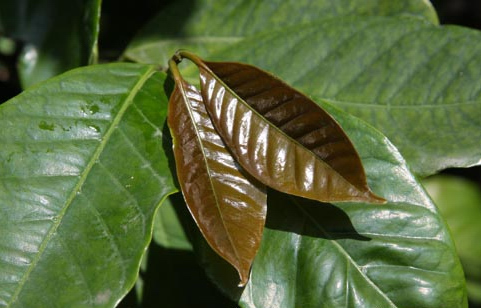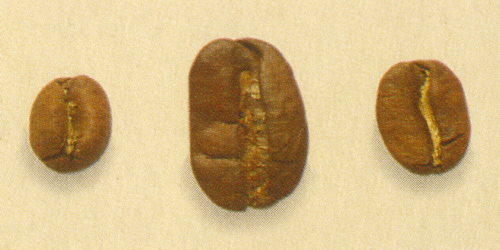SCAA Old Coffee Variety Introduction
Ethiopian Typica and Yemeni Bourbon are the oldest coffee varieties known so far. Many Arabica variants have been derived after they were transplanted from the country of origin to Central and South America and Asia. The small seed coffee cultivated in Yunnan, China is one of the Typica variants, and there are Bourbon variants in other regions.
Here are some on Typica and Bourbon:
Typica: the oldest native variety in Ethiopia, all Arabica are derived from Tibika. The top leaf of Tiebika is bronzed and the bean body is oval or thin in shape; the flavor is elegant, but the physique is weak, the disease resistance is poor and the fruit yield is less. Excellent manor beans such as the Blue Mountains of Jamaica, Manning of Sumatra and Kona of Hawaii all belong to Tibika.

Bourbon: a variant of the early (prehistoric coffee) Tibika transplanted to Yemen, the bean shape changed from a thin tip to a round body. It was named bourbon in 1715 after France transplanted round beans from Yemeni mocha to the island of Bourbon on the east coast of Africa (renamed Reunion after the French Revolution). Bourbon beans spread to Brazil and Central and South America in 1727, and the British transplanted Yemeni mochas to St. Helena Island (where Napoleon was later imprisoned) in 1732. Bourbon is the winner of the American boutique coffee cup test.
One of the characteristics is that the top leaf of Tibica is bronzed.
Gene mutant
Pointed Bourbon (Bourbon Pointu): found in Bourbon Island in 1810, beans changed from round to pointed, with only half the caffeine content, but in small amounts, weak and extremely precious (mostly cultivated in the laboratory).
Elephant bean (Maragogype, or Elephant Bean): Tibica's best-known variety of beans, first discovered in 1870 in the Maragogype bean-producing region of the state of Bahia in northeastern Brazil, is at least three times larger than the average Arabica, hence the name. The taste of elephant bean is poor in low altitude area, but it has better flavor at high altitude, mild sour taste and sweet fragrance.
Geisha (Geisha): a derivative of the Tibika family, it was exported from the Geisha Mountains of southern Ethiopia in 1931 (Geisha is synonymous with Japanese geisha). After being unknown in many countries, it was transplanted to Panama in the 1960s and did not begin to win cup tests until 2005.
Kenyan "SL28" and "SL34": the bourbon line, screened and cultivated by French and British missionaries and researchers in Kenya in the early 20th century, has adapted to Kenya's high-concentration phosphate soil for a century, giving birth to Kenyan characteristics of sour elves; top Kenyan coffee comes from these two varieties, but it loses its flavor when transplanted elsewhere.
Yellow bourbon (Bourbon Amarello, or Yellow Bourbon): a bourbon variety endemic to the Brazilian state of Sao Paulo, where the coffee fruit does not turn red and is orange when ripe. It was later found that the pericarp of other local bourbon-derived varieties also turned yellow.
Kaddura (Caturra): a single genetic variant of bourbon, discovered in Brazil in the 1950s. The long-term ability and disease resistance are better than bourbon, and no shade tree is needed; the flavor is equal to or slightly worse than bourbon.
Pacas (Pacas): the bourbon variety found in El Salvador, which was transplanted into El Salvador coffee farmer Pacas in 1935, yielded more results than other coffee trees of the same species in 1956. Experts were asked to identify and confirm that there was a genetic mutation.
Villa
The bourbon variety, which was first discovered in Costa Rica in the Sarchi:1960 era, has often appeared on the cup test list of excellence in recent years.
From left to right: Kenya round beans, elephant beans, Kenya AA

Arabica intraspecific hybridization (Intraspecific Hybrid)
New World (Mundo Novo): a natural cross between Bourbon and Sumatra Tibica, first found in Brazil. Because of its high yield and resistance to diseases and insect pests, it was widely planted in Brazil in the 1950s and was praised as the new hope of the Brazilian coffee industry, but the trees were tall and difficult to harvest.
Catuai: a hybrid of New World and Kaddura; short, wind-resistant, but monotonous.
Pacamara: a hybrid between Pacas (Pacas) and elephant bean (Maragogype), with a large bean body, second only to elephant bean, is an excellent variety produced in El Salvador in the 1950s, and has achieved good results in cup test in recent years.
Kent: the Tibica hybrid found in India has high yield and strong disease resistance, but has not achieved good results in the cup test.
Arabica hybridized with stout bean (Interspecific Hybrid)
Timor: a natural hybrid found in East Timor with 44 chromosomes, close to Arabica, but with a mediocre flavor.
Catimor: in 1959, the Portuguese mixed Brazilian Kaddura and Timo to develop a disease-resistant Cartimo. But the flavor is also poor, and it is an important variety of commercial beans at present.
Icatu: a Brazilian variety that has been improved for many generations and has been in the top ten of Brazil's Outstanding Cup.
Ruyilu 11 (Ruiru 11): a hybrid variety developed in Kenya in 1985 with heavy yield and low quality. There are no varieties of Arabica and sturdy beans that can be regarded as boutique coffee so far, so they are not available in many suppliers that specialize in freshly roasted boutique coffee, such as fresh. However, even many imported specialty coffee suppliers mix the hybrid beans with Blend to reduce costs. From the above-mentioned gene mutants (whether natural or scientific products), their flavor has a lot to do with specific geographical conditions. Even in the same country, coffee beans produced by different estates can vary widely. For example, the Blue Mountain of Wallenford Manor, a national treasure of Jamaica, is more than twice as expensive as the super-high mountain Blue Mountain of Jamaica.
Important Notice :
前街咖啡 FrontStreet Coffee has moved to new addredd:
FrontStreet Coffee Address: 315,Donghua East Road,GuangZhou
Tel:020 38364473
- Prev

Rwanda, an African coffee producer
The history of coffee in Rwanda is one of the most interesting coffee producers in East Africa. Rwanda, known as the Land of Thousand Lakes, grows coffee between 1700 and 2000 meters above sea level.
- Next

Twelve famous high-quality coffee producing areas in the world
one。 In 1808, coffee was first introduced to Colombia, which was brought by a priest from the French Antilles via Venezuela. Today the country is the second largest producer after Brazil. The origin of Colombian coffee: Jamaican Colombian coffee is one of the few original coffee sold in the world under the name of the country. In terms of quality, it
Related
- Guji coffee producing area of Guji, Ethiopia: Humbela, Shakiso, Wulaga
- What is the most expensive variety of Qiloso in BOP multi-variety group?
- How to store the coffee beans bought home?
- Why are Yemeni coffee beans so rare now?
- Ethiopian Sidamo all Red Fruit Sun Sun Santa Vini Coffee beans
- SOE is mostly sour? What does it mean? Is it a single bean? what's the difference between it and Italian blending?
- Is Italian coffee beans suitable for making hand-brewed coffee?
- How to choose coffee beans when making cold coffee? What kind of coffee beans are suitable for making cold coffee?
- Just entered the pit to make coffee, what kind of coffee beans should be chosen?
- Can only Japan buy real Blue Mountain Coffee? What are authentic Jamaican Blue Mountain coffee beans?

